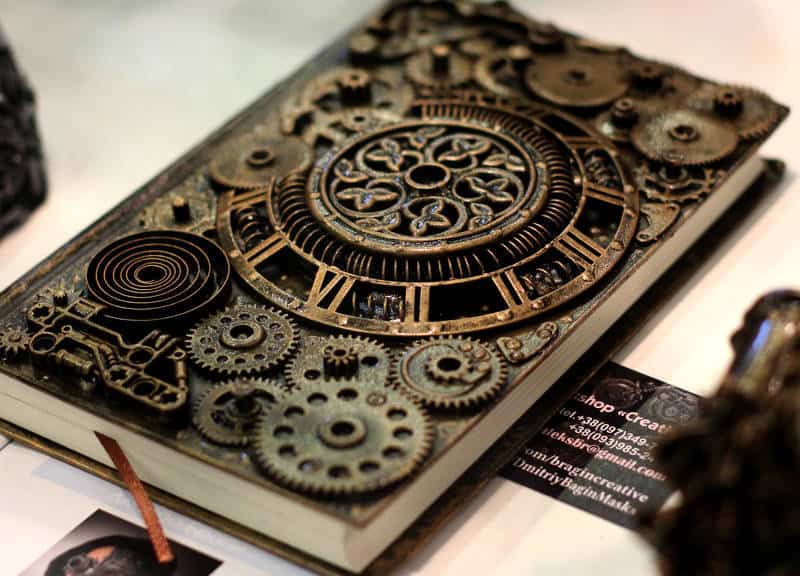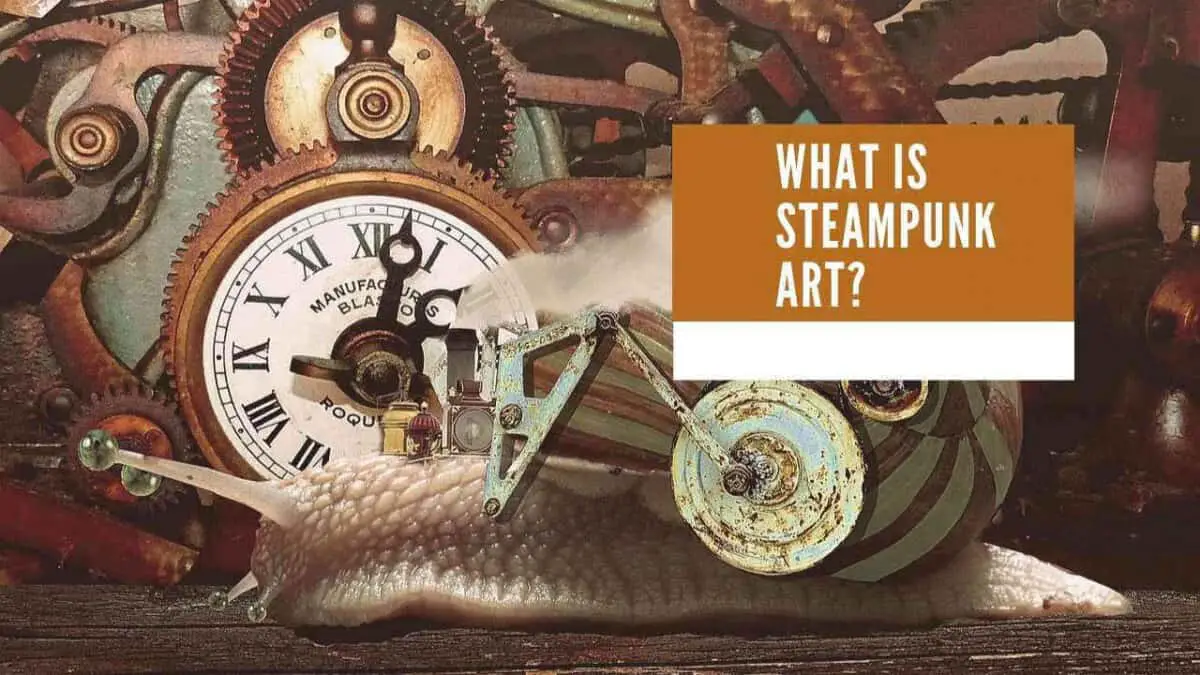If you’ve ever seen a modern-looking robot featuring parts of an old-fashioned watch or high-tech laptops outfitted with crude wooden and brass casings, you probably already have an idea of what Steampunk art looks like.
So what is steampunk art? Think of it as a mix of modern technology and ideas from the Victorian past when the Industrial Revolution was in full swing and steam was a major source of power. Steampunk culture primarily started with literature, followed by science fiction and then later come other forms of Steampunk art.
The Steampunk genre was first popularized in the 1980s but some of the components in this culture date back to the 8th and 19th centuries, and yet, others are borrowed from the future.

How did Steampunk art start?
As earlier mentioned, the steampunk art style has been in existence since the 1950s, but the concept of Steampunk was later popularized in the 1980s. At this time, the movement enthusiasts tried to solidify and define Steampunk as a cross point for genres of fantasy, science fiction, Victorian era, and industrialization.
Many scholars argue that the concept of ‘Steampunk’ existed decades before the term was coined, perhaps quoting the visionary stories of authors Jules Verne, HG Wells, and Mary Shelley churned out back in the 1800s. For more information about Steampunk see my post: What is Steampunk all about?
But Steampunk as a specific art form was identified with the coining of the phrase, so the 1980s would be an official beginning, though works and art elements from 100 years earlier can be included in the style, as mentioned in the beginning.
Today, Steampunk artists have emerged in different niches and genres, and in every community, adding momentum to the movement.
You will find tin, copper, and brass in canvas, steam pipelines hanging around Victorian mansions in posters, gears, and coils adding up to form exclusive drawings of owls, airships and futuristic machinery.
You can even find some Steampunk style in everyday objects such as a bed lamp. These are the main elements that add up for the Steampunk art style. For those who appreciate the movement, each massive sculpture to a single poster elicits the essence of a retro-futuristic Victorian era.

The Design & Art behind Steampunk Art
The Steampunk movement has significantly influenced modern art, and the reverse holds true too. Just like all other talented artists, Steampunk artists combine Steampunk elements (such as steam-powered automatons, gears, and springs, Victorian settings, steel, and brass) with their own natural modern style of creativity.
Even the non-Steampunk artists often unknowingly create Steampunk-themed works, pointing out just how attractive the idea of Steampunk is. Steampunk art movement promotes the DIY approach by artists where they’re encouraged to own futuristic designs of the past.
True Steampunk artworks are handcrafted, which is why Steampunk artists despise the repetitive nature of modern technology. So once you step into this niche, you will primarily be creating the uncreated.
Steampunk art Materials
Most Steampunk art materials are often what you will find when you step into an old industrial lot or science lab. For the sculptures, décor objects, and other physical elements, you will find lots of wood, copper, brass, steel, iron, and other heavy metals often comprise many of the pieces.
Other popular materials and elements you will notice with Steampunk art include glass, old-fashioned lightbulbs and watch parts, rivets, cogs, clockwork, levers, springs, gears, and other machinery pieces. You will also find leather, often stitched crudely in a heavy cord.
Steampunk art Applications
Steampunk art is primarily aesthetic and ornamental. There are thousands of beautiful and unique pieces of Victorian sculptures, ornaments, décor items, portraits, drawings, and illustrations. Since they’re always handcrafted with a delicate combination of modernism, virtual futurism, and Victorian past, Steampunk art pieces are highly unique, customized, sentimental, and often pricy.
Having said that, Steampunk art is not just for aesthetics; it also serves as the basis behind some modern machines and gadgets that actually function. We’ve reviewed here before some functional Steampunk gadgets, including steampunk computers, high-end coffee machines, memory sticks, cup holders, and so on.
Artists would often take a modern functional garget or object and modify its appearance by adding artistic elements of the Victorian and industrial era such as gears, cogs, brass, copper, wood, and leather.

Examples and Inspirations
There’re numerous examples of Steampunk all around us and in the mainstream media –sculptures, décor items, monuments, drawings, cartoons, animations, etc. Some of the most inspiring steampunk art came from movies, such as ‘Wild Wild West,’ which hit the big screen in 1999, featuring a giant, mechanical spider, owned by Professor Loveless and powered by steam.
Steampunk Style Drawing
Steampunk designs can be unpredictable, fun, cool, and pretty easy to draw too. If you’re into Steampunk style drawing, here are a few quick pointers on how to draw steampunk designs;
- Start with the basic outline –whatever steampunk design you want to draw, start with the basic outline without adding too many details in the figure at first. Freestyling the entire project without an outline can be quite challenging, and perhaps this approach should be left to technical drawing artists.
- Refine the outline –refine your general outline and fill in the larger details that make your drawing recognizable unless you’re drawing something completely random.
- Punk your drawing –Add in the usual steampunk culprit elements such as gears, switches, hydraulics, rivets, stitches, etc. to give your drawing an authentic look –but don’t overdo it.
- Nuts and Bolts –these are quite popular steampunk style drawings, and they’re sort of used to fasten things together. Small screws usually run along the edge of the plates while big screws often get their own space. You can simply use dots to symbolize small screws and circles for big screws.
- Scars and Shades: chances are some of the art elements used in the original design (real or imagined) are recycled and have scars and damages from the past. Let those dents and dings show through –it adds authenticity. Portray that in there and shade things up a little.

The Bottom Line
Steampunk art is fun and cool, whichever way you look at it. If you’re into visual or crafted art, steampunk art and drawing is a perfect opportunity to blend the Victorian past, the virtual future and the present moment into a creative work of art. Better still, if you’re looking to explore the simple and yet sophisticated genre of unique art that sets you apart, you should give Steampunk style art a try.
Etsy is a great place to find Steampunk Art



